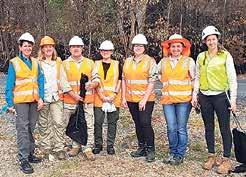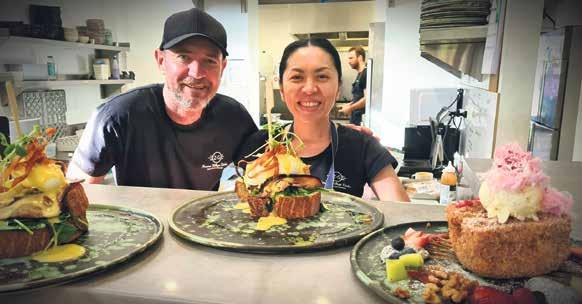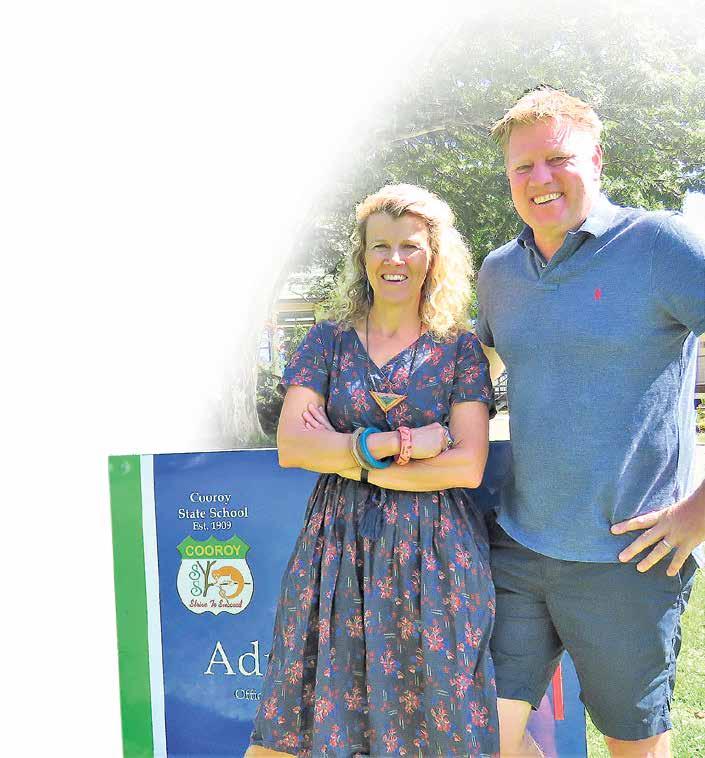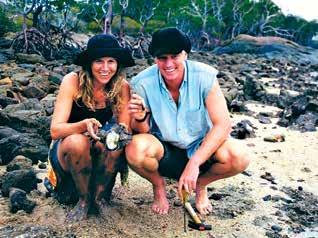
24 minute read
Community
The ‘Wagyu of pork’
BELLE VILLA FARM IS A PEACEFUL, BUCOLIC PLACE.
Advertisement

EVEN if the 300-odd hectares of two combined farms contains cousins Dean and Mason Mayne, their partners Krystal and Kate, six kids (three each), dogs and cats, cattle, 50 sheep, 300 pigs and 2000 chickens.
Together they make up the home of the chemical-free food grower Piggy in the Middle Farms just outside Kilkivan.
“We started out in Central Queensland, where we grew up,” Mason said.
“We were part of a family partnership, parents and grandparents - we’d always be together working.
“I had a few sheep and pigs. I was processing them for ourselves and the family.”
“We decided to come down this way for the climate, and to be closer to markets, as there were far fewer people up there.
“Deano had pigs, I had sheep, now down here we’re into everything.”
Growing up in Central Queensland, Dean said “We were broadacre farmers, with lots of chemicals.
“That was one of the advantages in coming down here, to be chemical-free.
“Now there are no hormones, no antibiotics in our feed.
“There are no yolk enhancers in our laying-hens’ feed – it’s just as natural as we can get it and the animals really benefit from it as well as us and the consumers.”
The farm is totally free-range.
“I saw the way we had been farming, the land was deteriorating, and I started searching for a way that we could regenerate the land,” Mason said.
“I came across a few different people doing a few different things.
“These were farmers operating around the world, so I started down the path of regenerative farming, by having the animals and moving them around.
“We started seeing the benefits of the land, also the animals and the quality of the meat.
“So the idea, when we moved down here, was to run pigs, sheep and chickens for meat, also eggs, and we set it up in 2016.
“All our pigs, sheep and chickens are free to forage on natural pastures every day of their lives.
“Because we practice rotational grazing, our animals are constantly moving away from their droppings and onto fresh pasture, which they love.
“The heritage breed pigs have fresh water and muddy wallows always available, and our Dorper sheep are totally free ranging and 100% grass-fed, while the chickens are on fresh open pasture scratching and aerating the topsoil as they go.”
Mason and Krystal’s passion for the land led them to explore the concept of holistic grazing methods.
Seeing the benefits to both animals and pastures led them to investigate conventional beef production; not only where food was produced, but the journey it made to the consumer.
For Dean and Kate, some food allergies meant they wanted to question the food their young family consumed.
Because of his interest in heritage breed pigs and a background in butchery, Dean began to produce healthier alternatives for the family.
His chemical-, nitrate- and gluten-free meats and smallgoods were soon in demand with extended family and friends.
Regenerative agricultural practices were fundamental to their approach to farming, he said, so they employ systems that aimed to strengthen the health and vitality of the soils. “This is because healthy soils produce healthy, mineral rich grasses - which in turn produces healthy livestock. “As well as regenerating topsoil, these systems increase biodiversity, improve water cycles, enhance ecosystem services and support bio sequestration.
“As a result, they also increase the farms’ resilience to increasing climate fluctuations.”
Dean said he was often asked “what makes our pork taste so good”.
“It’s not only that our animals are raised on pasture - : our pork is heritage-bred.
“While these breeds take longer to raise, it’s well worth the wait.
“There’s more flavour and tenderness.
“Chefs often refer to it as the wagyu of the pork world.”
The team has also developed and built a processing facility on the farm.
“We process all our meat and products and we’ve got a smoker there as well so we do all our own nitrate-free smoked bacon and ham, and a lot of smallgoods as well,” Mason said.
“A lot of our products are preservativefree.”
It’s a big operation – and the kids don’t get a full pass when it comes to farm work either.
“From an early age they’re involved in feeding, watering and moving of livestock.
“They gather and pack eggs with remarkably few breakages. They help at birthing time and are especially good at cuddling the newborn piglets and those cute-as lambs.”

All our pigs, sheep and chickens are free to forage on natural pastures every day of their lives. Club Piggy Meatbox Delivery
The older kids have skills their peers might envy, like driving tractors and quad bikes, and helping in the butcher house (especially making sausages) and instructing their dads on how to serve customers at the markets.
“They have a real appreciation for life and death on the farm, and a respect for the contribution our animals make to feeding themselves, and others also.”
The move south has been a big change for Mason. It’s a big change from big broad acres and cattle.
“We first started here doing farmers’ markets - Noosa and Kawana – then branched out to Brisbane, Gympie, and have grown from that.”
Now they do weekly delivery runs to Noosa and the Sunshine Coast with drops at Tewantin and Maroochydore, as well as Gympie, and fortnightly runs to Brisbane.
They are also one of the earliest members of the Slow Food Noosa movement, with a Snail of Approval award received in 2016. The program aims to inspire producers, chefs, restaurant owners and food outlets to use and promote good, clean and fair ingredients from our local area.
“We were in the first year, when they started, and we’ve stayed in since,” Mason said.
“People are asking where their food comes from, these days.”
Business is all one-way: up.
“We’re still growing - there’s plenty of potential to grow and we are.
“Our small goods are very popular, you will find them at many of our stocklist and in the near future IGA stores.
“Delivering directly to families from our farm has been our focus, Club Piggy allows us to connect directly to those who value quality food and want to know where it comes from. Club Piggy Meatboxes are ordered directly from our webpage.
“Our Club Piggy Mixed boxes contain either a combination of pork, chicken and eggs – in small, medium or large sizes, or pork only – in medium or large sizes.
“All you have to do is decide which box best suits the tastes of your household.”
You’ll be able to get lamb packs seasonally, too.
“When we receive the order, you’re given a link to a private Club Piggy Facebook Group, where you’ll get information about the farm, delivery changes, recipes etc.
“Depending on availability, you can also include additional chickens or small goods – which we will tell you about via the Facebook Group each month, before we pack your order.”
It’s not surprising the farms’ products are so in demand, given they are the epitome of clean food.
“We try to do the best by our animals while they’re here, in the pasture-raised system,” Mason said.
“And by doing that, it’s the best for the land, it’s the best for the animals, and we produce the best products that we can.” Contact info@piggyinthemiddle.com.au or call Dean on 0427 562 818, or Mason on 0409 099 565, or via Facebook
Mucking about. Pigs getting a grain feed to supplement their diet, with Dean and Mason looking on.

Buy Direct from the Farmers
Our Club Piggy Meat Boxes are delivered to Gympie, Sunshine Coast & Brisbane

• PORK • EGGS • CHICKEN • LAMB • BEEF

Locally Grown Pasture Raised Chemical Free

The littlest Guard dog on duty





Time to light up
“DAD, I’m going to put the Christmas lights up”. “But Dom, it’s only October.” This is now an annual conversation at 3 Dianella Court, Cooroy. Dominic Noonan, aged 13, has been decorating the family home for three years.
“I do it all myself except the roof. My parents aren’t really into it, but I made friends with my neighbour Wendy up the road. Her display is really good.
“Me and Wendy talk about the new lights she likes. She tells me about the websites and shops where she gets hers.”
Wendy (of Cooroy’s Kindness Club) agrees. “Dom does an amazing job. We definitely bonded over our love of Christmas lights. He’s a very special young man. He shines brighter than all our lights combined!” In Dianella Court there are usually five houses that decorate for Christmas. “My house is the first you see, but I want to make it good so people keep driving up the street to look at the other lights.”
Dom’s biggest thrill was seeing his lights on the Channel 7 news last December. He’s hoping for the same this year. “I want Cooroy to become a Christmas light capital,” he said. Keep it up Dom, you’re doing a great job!




NOOSA BIOSPHERE GALA SHINES LIGHT ON KOALA CONSERVATION
Koala expert panel at Noosa Biosphere Wild Koala Gala
THE Noosa Biosphere Reserve Foundation held its Wild Koala Gala on Tuesday November 2, celebrating community action for koala conservation in the region.
Foundation Chair, Rex Halverson said the Noosa Biosphere Wild Koala Gala focused on the challenges and opportunities for sustaining our local koala populations.
“There is no more iconic species than the koala. And Noosa is one of the few places left where you can live and work amongst them, which contributes to the very special nature of living in the Noosa Biosphere Reserve,” said Mr Halverson.
“It was our intention that the Gala ignited an urgent call to action to support our local koala populations and highlighted the incredible work that is currently underway across our Shire.”
A panel of koala experts discussed the plight of the koala and what is being done in the region to protect the vulnerable species.
“Our panel of experts are leading the charge for koala conservation. Groups like Noosa & District Landcare, Australia Zoo Wildlife Hospital, Queensland Koala Crusaders, Detection Dogs for Conservation and researchers at the University of the Sunshine Coast, are all playing a major role in protecting koalas and their habitat.
A personal video message to Noosa was also received from world renowned conservationist Dr Jane Goodall, ambassador to the 50th Anniversary of UNESCO’s Man and Biosphere Programme who reinforced the urgent need to conserve biodiversity and for communities to live sustainably.
The Noosa Biosphere Reserve Foundation launched its Noosa Wild Koala Initiative and Fund to develop a coordinated approach to koala conservation.
The Gala helped kickstart the initiative with $27,000 in donations raised through a silent and live auction. Event partner, Queensland Koala Crusaders matched this with an additional $25,000 added to the Noosa Wild Koala Fund.
Winners of the inaugural Noosa Biosphere Awards were also announced at the event. Noosa and District Landcare won the Land category for their Keeping it in Kin Kin project. Noosa Integrated Catchment Association took out the Water award. Rachel Lyons was awarded the Wildlife category, and Noosa Environmental Education Hub won the People and Economy award.
“We are thrilled with the results of our second Noosa Biosphere Gala and thank our sponsors, supporters, and everyone who attended. Congratulations also to the finalists and winners of the Noosa Biosphere Awards – we’re so pleased to now have a platform whereby we can recognise the efforts of those who work so hard to maintain the Noosa Biosphere’s special nature,” said Mr Halverson.

Wishing everyone a Happy Christmas & Safe New Year - Thank you for all your support - Nige & Dave Wimmers Lane, Cooroy I PH: 5391 3440 I www.theshedcompany.com.au

If not you, then who? Finding Rachel Lyons
By Margie Wegener
CATCHING up with Rachel Lyons is a bit like spotting a koala. You’ve got to be patient and lucky. The last place you would expect to find her is chained to a keyboard in a Brisbane hotel, diligently preparing for an AGM whilst simultaneously wrapping up a course on drone use.
“I like to fly below the radar and work behind the scenes as much as I can, only popping my head up when I need to. Less distraction that way. I despise talk for talks sake and just like to get on with things – not enough time in the day otherwise,” she says.
Rachel is quickly adapting to new technology, including thermal drones, which are used for wildlife search and rescue, and flora and fauna surveying, dividing herself between her day job as Noosa Landcare’s Business and Partnerships Manager and her volunteer role with Wildcare Australia.
This lady wears many hats. “The saying ‘If not you, then who? If not now, then when?’ has always resonated with me. I see volunteering as a duty, as a responsibility to give back to the world we live in. And I get bored very easily. My mind never stops so I keep busy doing things I think are important”.
That important work in land management and the natural resources industry forms a long list of achievements. She is a behind-the-scenes change maker, known for her ability to create profitable partnerships. Most recently, she was recognised by the Noosa Biosphere Awards, winning the Wildlife Category. The awards acknowledged her commitment as an active volunteer in wildlife rescue and rehabilitation, and her direct impact on co-leading the Noosa Region Koala Rescue Team (84 rescues since July, excluding health checks).
“I have been in Wildcare for around 22 years now, as they are one of the most professional and scientifically based wildlife groups in existence in Australia – both aspects that I value highly. In the time I have been with Wildcare I have met many life-long friends who share the same dark warped sense of humour you only get through sharing not-so-pleasant experiences and late nights searching for animals in the bush”.
Rachel led the team that managed Noosa’s wildlife response during the 2019 fires and later developed the Emergency Response Trailer to prepare for similar events. “The greatest challenges I see into the future for wildlife is climate change and the risk it poses for forests and water resources. We are already seeing the effects of it, probably best exemplified by the 2019 drought and subsequent fires.”
The Greater Glider which Rachel identifies as her most loved animal is now listed as endangered nationally given how much they suffered during and after that horrific 2019 summer.
“I saw my first wild Greater Glider the night I moved on to my property in Pomona over 20 years ago. I was so excited to have them living around me and to be guardian of the big habitat trees where they sleep. Apart from the fact that they are exquisite, I am drawn to animals that are obscure and unique. Most people would have no idea they have them on their property as they are quiet and reside high in the tree canopy. They are one of the hardest animals to rehabilitate, which I take as a challenge.”
As elusive as her beloved gliders, you might not see her, but Rachel Lyons’ work is all around us. How fortunate for us, and our unique wildlife.
“I am the eternal optimist. I have the bigger picture always in mind and am hopeful that the amazing gains made in the conservation and environmental sector over the last twenty five years continue.” If not now, then when?




FreshLocal SEAFOOD for CHRISTMAS
COOLUM
Thursday 23RD December - 9am-12pm NOOSA
Thursday 23RD December - 1pm-4pm COOROY
Friday 24TH Christmas Eve - 8am-1pm
CHRISTMAS ORDERS CLOSE @ 6PM MONDAY 20TH DECEMBER Fishing you a Merry Christmas & Happy New Year
NORMAL TRADING COOLUM
RSL GROUNDS THURSDAYS 9.30am-5.00pm NOOSA
TIGERS AFL GROUNDS FRIDAYS 9.30am-5.00pm COOROY
MAIN STREET
SATURDAYS 8.00am-1.00pm PH: 0427 397 826

• Breakfast • Lunch • Takeaway

OPEN: Tuesday - Saturday 7.30am - 2.30pm Wednesday - Roast Night 5pm-7pm - Pre Orders Welcome Sunday Funday 8.30am - 12pm
Fully Licensed New Cocktail Menu
BOOK FOR YOUR FESTIVE CATCH UPS @ PVK

Mr G’s fascinating Journey
COOROY STATE SCHOOL TEACHER PHIL ‘MR G’ GIBLETT IS NOT ONLY NOW TEACHING THE CHILDREN OF SOME OF HIS EARLY STUDENTS, AFTER NEARLY 21 YEARS AT THE SCHOOL, HE’S NOW TEACHING SOME OF THEIR KIDS. By Alan Lander IT’S a long way from where the now 52-year-old started life in rural Victoria, and whose first major teaching employment was in a refugee camp in Swaziland.
“I was born in East Gippsland where my parents had a dairy farm,” Phil said.
“When milk ‘went bad’ in the seventies, we bought a general store in Briagolong, selling everything [and] being newsagent, the bank, post office – then I went to Melbourne University to study environmental science and a Bachelor of Education.
“That was going to be the big thing in the late eighties and early nineties: everyone was talking greenhouse effect, CFCs, and people started putting a monetary value on [the environment] and telling us every multinational would have two or three environmental scientists employed.
“But within 18 months it was gone; it was nothing.”
Ironically, 30 years on, “we are getting to where we were then,” he added.
But it was a double whammy for Phil, as then premier Jeff Kennett was closing government schools across the state, and graduate teacher interviews were running up to two years behind schedule.
“By chance, Australian Volunteers Abroad came to the university one day, so I went and listened.
“AVA said we could work overseas with no experience on a one-year contract, where previously it had been two years. So, we were the pilot program team to go over.”
Phil was sent to Swaziland, a small country surrounded by South Africa (controversially re-named Eswatini since 2018) to teach geography at a refugee camp, most occupants of whom were victims of a 20-year civil war in neighbouring Mozambique.
“It was hard. It was all the British education system,” Phil said.
“There was no TV or video in the schools, or any other appliances like photocopiers.”
Not much else, either.
“There was no oven in the house or washing machine, or fridge. I hand-washed my own clothes for the first year, but was told to employ someone to do it, because if you’re earning money there, you should employ people.
“By my final year we didn’t have running water. UNHCR came to install taps. They left at the beginning of 1994 saying ‘we’ll give you a year to figure how to pay to run the pump’. By January 1995 nothing had happened, so they cut the power off.
“[From there] water delivery would come in once a week. It was dam water – you couldn’t drink it, but we’d fill up tanks at school, we’d fill up buckets for showers. “I’d buy two litres of Coca-Cola at the end of each day, having had nothing to drink all day - so the first bottle didn’t touch the sides. I would leave a little to brush my teeth with.” Regular toilet flushing was also unavailable, so “I’d [bucket-] flush twice a week - Wednesdays and Sundays.” Phil said despite good intentions, “white people would find it difficult to understand culturally.” “Traditionally women used to collect water at wells to get away from the men, and talk. That all broke down. Women enjoy that social fabric of walking together to get water.” He stayed three years, and in his second, he met his Chinchilla-born wife Rosie Lloyd there – a fellow teacher and soon-tobe accomplished artist - who was on her first year. In 1994, the buildup to the South African election of Nelson Mandela created tension throughout southern Africa. Threats were being made against whites, including Phil and Rosie. Australian government workers in the capital cities had evacuation contingencies in place for leaving the country if safety was compromised, but teachers like Rosie and Phil did not – so they hitch-hiked across the border to Mozambique. They left in late 1995 but, as AVA had predicted, readjusting to the firstworld, everything-at-hand conditions of Australian life, proved hard for them both. “Death, AIDS, dysentery, no latrines or running water for months – to adapt back to Australian life was nearly impossible. Comparing life and priorities here to that camp, it all seems so much more complex here than there.” They headed for Darwin and picked up work at Barunga, a small Aboriginal community near Katherine. “It’s a great community and very traditional,” Phil said. But after a year or so, Rosie’s parents wanted her back in Queensland. After a home visit, “we were driving back to Barunga, having applied for Queensland posts but not having heard anything.” “Then, driving through the town of Roma, someone tried to flag us down. “We just carried on, then near Tambo, a police car stopped, turned around and started pursuing us. “We were only driving a little Toyota. We stopped and the officer asks if Rosie Lloyd is travelling with us. ‘Her mother’s been trying to stop you at Roma and other places,’ he says. “Rosie had been offered a job at Mossman in far-north Queensland, and her mother had described the car to Tambo police, asking to wave us down.” The pair drove to Longreach before deciding which direction to take: north or west. They decided on Mossman, organising someone to pack their Barunga house up for removal. “Rosie was teaching art in high school in Mossman. I ran a behaviour management program for students at risk and suspended, for six schools covering Port Douglas, Mareeba and other towns. “It was great, but we always wanted to go back into an Aboriginal community. “We stayed there for a year and kept applying for other jobs, finally getting positions at Lockhart River. “We spent three years there. Rosie worked with the famous Art Gang and was teaching at the school. “In the NT it was the first time I taught primary students and at Lockhart I also taught primary and did a deputy principal stint. “We stayed there for three years, then decided to move south to start thinking about having kids ourselves – and I was getting a bit burned out by then anyway. “Lockhart was great, but we were getting to the point where we wanted to go and buy a newspaper that was printed on the same day, or be able to get fresh bread. “We’d been remote for eight years which was highly valued by the department, but it gave me the chance to be specific about where I wanted to work next - and that’s when I got Cooroy. “Rosie’s parents had bought a unit in Sunshine Beach in the early nineties, we’d loved it and knew this was the [region] we wanted to live. “Houses were $150,000 back then in Sunshine Beach, but then we thought we couldn’t handle such small spaces after our remote experiences.” The pair bought cheaply in Doonan, followed by 13 years in Miva St, Cooroy, and now live in Noosaville. Here, they “For my midlife crisis I bought a cake shop rather raised their four children, rising golf star George, 20, Tilly, 18, a first-year paramedic, with Grace, 17, and Gemma, 15, still than a car.” completing school studies. Rosie Lloyd and Phil Giblett at Cooroy State School

Meanwhile, Phil heads for a twenty-first anniversary milestone, while Rosie teaches two days a week at the school, also developing an enviable reputation in the art world.
“She was recently featured on Gardening Australia, which you can see online.”
He has predominantly taught upper primary, but is heading back to Year 6 next year – and he is bemused about now teaching some children of his first students.
“It’s the first time I’ve had the next generation in, after teaching their mum or dad.
“It does make it interesting. Also, now I’m playing cricket with one of my ex-students; he has become a teacher and is now teaching my daughter. That’s what being part of a community is about.”
When living in Cooroy, he said “I’d never leave”.
“But raising a young golfer and my daughters’ surf-based activities, getting closer to Noosa reduced travel times.”
“One thing I miss is the trip to Cooroy IGA – it always took so long to get in and out, with impromptu parent/teacher/student meetings taking place in the aisles.
“Now I live in Noosaville, no-one knows you.”
Phil said when he first arrived, the town and school population was growing.
“But the school demographic is changing with the increasing cost of housing, and no rentals available,” he said.
“A lot of schools around here are experiencing the same thing with younger families being pushed out.”
One new thing for Phil is his recent purchase of the Buttercups wholesale business off Maple Street, for which he now takes Thursdays off school to run.
“For my midlife crisis I bought a cake shop rather than a car,” he quipped.
He was friends with the previous owners Andy and Katie Thin, and they got talking.
Phil said he has since increased the wholesale side of the business – and he will be expanding the retail side to coincide with the opening of the new Cooroy Playground.
“I just think the new playground will be a big attraction,” he said.
“At the moment, we supply local businesses with muffins, chocolate brownies, carrot cakes and logs, scones, cherry and apple pies, veggie tarts, bacon thingies – a whole range.
“I have to think about a future transition away from teaching because after 30 years a change is as good as a holiday.
“It seems like a good opportunity.”

Phil and Rosie at Lockhart River collecting oysters in 1999

Barunga Class photo 1996
The Connecting Noosa Christmas Convoy is back from December 6 to 9, involving emergency service vehicles from QFES, Police, Ambulance, SES, Rural Fires, Volunteer Marine Rescue, Council’s Local Laws team, plus Santa. Stand in your driveways and give us a wave. To find out when the convoy is coming to a street near you, scan the QR code.

The Noosa River has maintained its A- quality score in this year’s Healthy Land and Water Report Card. Noosa’s freshwater creeks were in excellent health, with a slight improvement in aquatic insect health at Ringtail Creek. Thumbs Up!
Noosa Council is disappointed in the decision in the Planning and Environment Court where it was unable to stop quarry truck movements during school bus hours on the Pomona Kin Kin Road. Council will now progress its application to the Planning and Environment Court seeking full enforcement orders centred on alleged breaches by the Quarry operator and seek to address the intensification of use issues.
Noosa Council has announced a revised construction schedule for the Hinterland Playground which will see the unique nature-based, all-abilities playground open to the public in March 2022.














